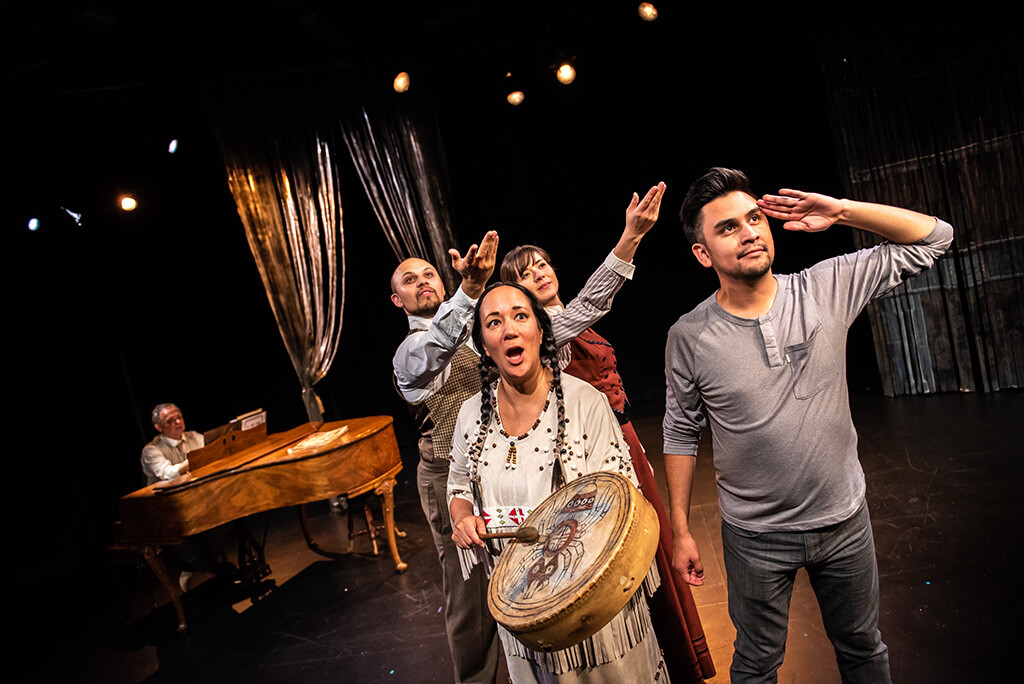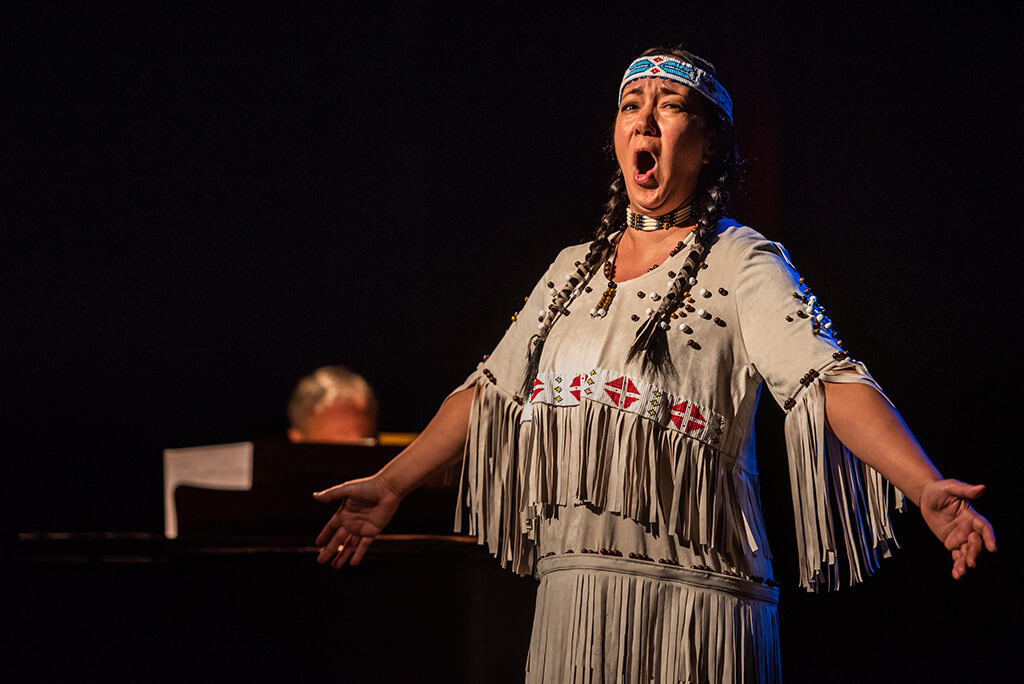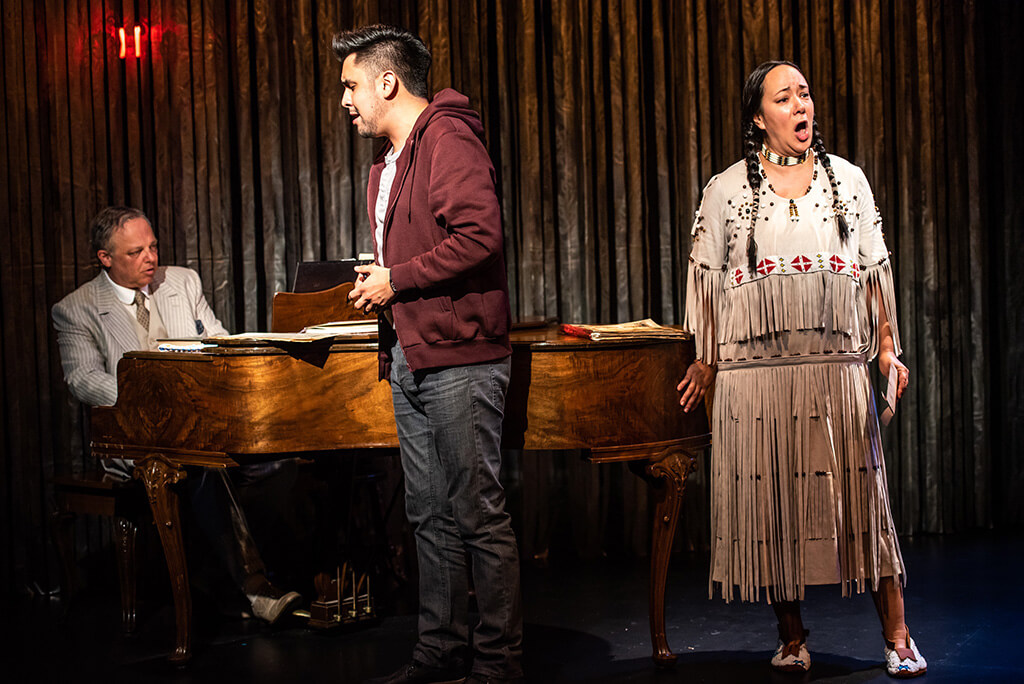
Paper Canoe Projects, Cahoots Theatre, Native Earth Performing Arts/ I Call myself Princess by Jani Lauzon, directed by Marjorie Chan, Aki Studio, Daniels Spectrum, Sept. 13 to 30. Tickets available at 416.531.1402 or www.cahoots.ca. Full Concert Listing HERE.
Revealing little-known stories is one of the great functions of theatre, and I Call myself Princess, by Métis performance artist Jani Lauzon, is a unique theatrical experience.
Lauzon refers to her new work as “A Play with Opera”, and it is an apt description. The piece is filled with excerpts from Shanewis (The Robin Woman), an “American opera” that was performed at New York’s famed Metropolitan Opera House in 1918. Composer Charles Wakefield Cadman and lyricist Nelle Richmond Eberhart were part of the Indianist movement, and it is this fascinating chapter of American musicology history that underpins Lauzon’s play.
Cadman and Eberhart’s opera was inspired by the life of Tsianina Redfeather, a Creek First Nations mezzo-soprano from Oklahoma. Tsianina partnered with Cadman for 20 years, touring throughout the United States performing concerts of Indianist music. In the late nineteenth and early twentieth centuries, ethnologists would travel to Indigenous communities recording their traditional songs. Composers like Cadman would then “idealize” these tunes into what became popular songs of the day, aided and abetted by new English lyrics provided by the likes of Eberhart. For example, one of the most famous of the duo’s songs, “The Land of the Sky Blue Water” (1909), is an idealized version of an Omaha tribal love song.

While in present-day terms, the Indianist movement was cultural appropriation at its worst, Cadman, Eberhart and their colleagues were trying to both create a uniquely American musical idiom, as well as save Indigenous music by idealizing it. As Lauzon points out in her program notes, Tsianina believed, along with the Indianists, that Native Americans were a dying race, and idealization was the only way to preserve the Indigenous legacy. Hence, her concert tours with Cadman where she was billed as an Indian princess in Native dress.
Lauzon, however, did not set out to write a docudrama. Her clever script weaves two distinct storylines together. On one hand, there is Tsianina (First Nations mezzo-soprano Marion Newman), her relationship with Cadman (Richard Greenblatt) and Eberhart (Courtney Ch’ng Lancaster), and the composing of Shanewis (The Robin Woman). On the other, there is present-day Indigenous tenor William Morin from Winnipeg (Aaron Wells), who has won a scholarship to further his opera studies in Toronto. Alex Park (Howard Davis) is William’s black boyfriend back in Winnipeg. (Both Lancaster and Davis also play other characters as needed.) William has arrived in Toronto angry, feeling keenly the injustices that Indigenous people have had to suffer over the years. One of the first projects he is given is Shanewis, and this blatant cultural appropriation makes him even angrier. He can’t fathom how his people gave up their traditional songs where they now languish in white museums. William begins research into Tsianina, and in due course, they find each other as “the seen and unseen worlds” merge. Tsianina’s influence on William ultimately influences the course of his life’s work.
There are a plethora of themes roaming around I Call myself Princess. A key point is white stereotyping of “Indians” manifested in how Tsianina is forced to dress and behave, and the insult of William being handed what he sees as a third-rate opera because he is Indigenous and so is its story. All kinds of questions arise. What is the indigenous legacy and how to preserve it? Can cultural appropriation be reversed? What can be learned from past Indigenous generations, and how can these influences be used for positive advantage in the future? How do First Nations young people carve their own pathway that embraces both their traditions and modern society? What image should Indigenous people present of themselves? A really strong thread is how well-meaning colonials/settlers (aka white people) are perhaps more dangerous to Indigenous survival than outright enemies.

As music director for the show, Lauzon brought in Jerod Impishchaachaaha’ Tate, a Chickasaw from Oklahoma, whose career is devoted to the development of American Indian classical composition, and he has clearly worked very carefully on the presentation of the score. In truth, one is very aware of the Native cadences within Cadman’s compositions. Performing that music falls to Greenblatt, whom we know has classical training in as much that he was a co-creator of the beloved Two Pianos, Four Hands. His piano playing, which he performs with gusto, carries the show. At this point, I have to confess that I have always had a penchant for nineteenth-century parlour music, so I like Cadman’s compositions, as perverse as that may be. Cadman also wrote some rather intricate ensemble pieces for the opera Shanewis that will surprise people.
Mezzo-soprano Newman’s voice has always been lush and expressive and she excels in this performance. Her acting is a little restrained but it suits the character. Wells’ tenor is a bit pinched on the top, but he is essentially an actor who does convey William’s angst in suitable inner turmoil fashion. Greenblatt’s Cadman is a bit bland, but then he is an old-fashioned gentleman. The best acting comes from Lancaster and Davis, and they provide the bite to the drama, plus singing well enough when required. Director Marjorie Chan has done a slick job in merging two different worlds, a century apart, into an effective whole, and deserves kudos for the seamless insert of the musical interludes. The production itself is impressive from many standpoints including costume designer Snezana Pesic’s period look.
In summarizing Lauzon’s achievement in I Call myself Princess, she has taken a little-known fact about an early twentieth-century Indigenous opera singer, and through extensive research, has opened up Tsianina Redfeather’s world to embrace the present time in all its complexities.
- INTERVIEW | Actor Diego Matamoros Takes On Icon Walt Disney In Soulpepper Production Of Hnath Play - April 16, 2024
- SCRUTINY | Opera In Concert Shine A Light On Verdi’s Seldom Heard La Battaglia Di Legnano - April 9, 2024
- SCRUTINY | Lepage & Côté’s Hamlet Dazzles With Dance And Stagecraft Without Saying Anything New - April 5, 2024



